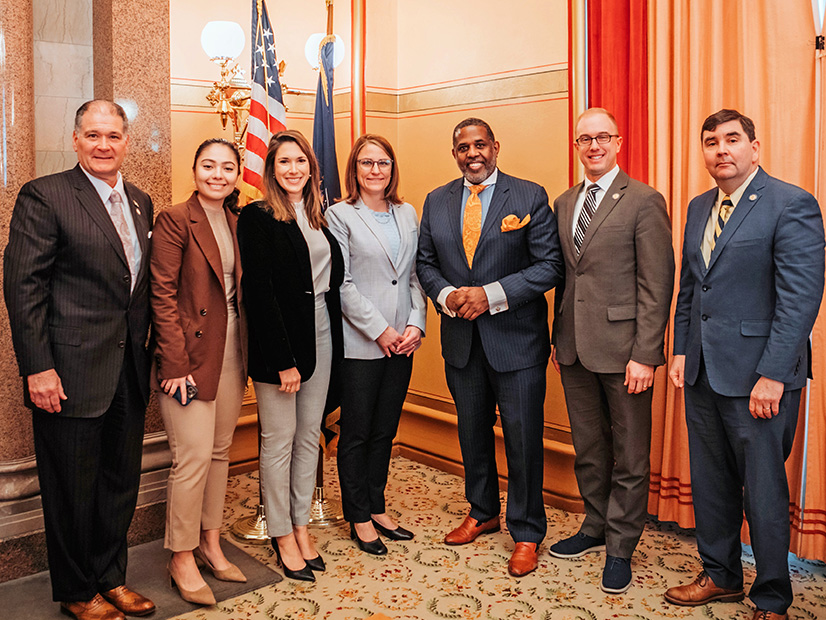
One of the architects of New York’s energy transition plan presented its challenges as opportunities while speaking to state legislators Thursday.
Doreen Harris, president of the New York State Energy Research and Development Authority, told members of the Senate Energy and Telecommunications Committee that the state will reap benefits from decarbonizing its grid. The massive costs will be met in part through federal spending or tax breaks, she said, and assistance will be available for lower-income New Yorkers.
Harris was co-chair of the New York Climate Action Council, which drew up the scoping plan for the landmark 2019 Climate Leadership and Community Protection Act. And as head of NYSERDA, she is now a central figure in carrying out the energy transition mandated by the CLCPA, at a cost of hundreds of billions of dollars.
The scoping plan, completed in December, was a framework for the executive and legislative branches to work from; Senate and Assembly leaders are now hashing out key spending and policy details with Gov. Kathy Hochul as the state approaches the April 1 start of its 2023/24 fiscal year.
Harris ran through some of the major points of the plan — a cap-and-invest system to reduce emissions; building decarbonization; prioritization of disadvantaged communities; and extensive buildout of generation, storage and transmission — before taking questions.
Sen. Mario Mattera (R) asked Harris if she thought New Yorkers are sufficiently informed about the energy transition and all it entails.
The CAC’s meetings in every region of the state and the 35,000 comments it received show the effort was made, Harris said, but more could be done, particularly to combat the notion that the transition would be undertaken — and paid for — in a year or two, rather than over the course of decades.
The cost of New York’s energy transition has been estimated at $275 billion, or $14,000 per state resident. That does not include energy efficiency upgrades and electrification of millions of homes and businesses.
Mattera asked if the cost of retrofitting homes for all-electric operation would cause residents — who have been moving out of state at the highest rate in the nation — to relocate in even greater numbers.
Harris said it might prompt residents to stay for the employment and business opportunities the transition will create and prompt residents of other states to move to New York.
“In fact, what we’re talking about is an extraordinary amount of investment we’ll be making in this transition,” Harris said, “and I would say, an extraordinary amount of opportunity that will come forward from that. It needs to be looked at through that lens.”
When Mattera pressed her on utility ratepayers bearing the cost of grid modernization and expansion, committee Chair Kevin Parker (D) interjected that even if the state repealed CLCPA tomorrow, there would still be costs for grid maintenance and modernization.
But Parker acknowledged concerns about beginning the transition before planning is complete, or “building the plane after takeoff,” as others have called it.
“This is such a massive undertaking that we have to walk and chew gum at the same time,” Parker said.
Sen. Kristen Gonzalez (D) — whose New York City district contains “Asthma Alley,” the cluster of fossil-fired power plants that degrade air quality in nearby neighborhoods — asked about the economy’s impact on the transition.
Inflation, interest rates and supply chain constraints have caused problems for multiple clean energy sectors, including the offshore wind farms that downstate is counting on to replace fossil fuel generation.
“It is a particularly challenging time in the near term for frankly all projects of any type,” Harris said. “The clean energy investments we’re making are particularly challenged.”
Upstate solar and wind developers have expressed concerns, Harris said, and port development to support offshore wind has been affected as well.
No existing clean energy development contracts have been adjusted for inflation, nor are any negotiations underway, she added. But NYSERDA has begun putting an inflation-adjustment mechanism into new contracts, she said.
Sen. Mark Walczyk (R) asked why single-family residences are being targeted first for the phaseout of fossil fuel systems and multifamily residential buildings at a later date.
Walczyk, whose district is upstate, pointed out the “upside-down” impact of this: Upstate areas that have cleaner air and a larger percentage of single-family homes will see their housing stock decarbonize sooner than Gonzalez’s district and other parts of New York City, which has dirtier air and a larger percentage of multiunit dwellings.
It is relatively the easiest place to start, Harris started to say.
“It’s not the easiest for the single-family homeowner,” Walczyk interjected. “It might be easy as a governmental policy.”
“We need to start somewhere,” Harris replied. “We agree these are the largest source of emissions in our state. I would fully agree without you, buildings are the heart of the biggest challenge before us.” That is why new construction is targeted for zero-emission requirements, she added: It is much easier to build new than retrofit an existing structure.
Among his other points, Mattera said residents should not have to time their lives around the electric grid’s peak hours, washing their laundry at midnight and waiting for a good time to recharge their car batteries.
Sen. Michelle Hinchey (D) said this line of thinking does not give residents enough credit for being adaptable. The choice, she said, is between making small adaptations to help fight climate change or huge adaptations to respond to climate change.

